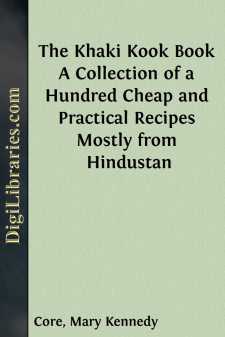Cooking
- General 70
- History 1
- Reference 10
- Regional & Ethnic 3
- Vegetarian 10
Cooking Books
Sort by:
by:
Hannah Wolley
THE Queen-like CLOSET, OR Rich Cabinet. 1. To make Aqua Mirabilis a very delicate way. Take three Pints of Sack, three Pints of White Wine, one quart of the Spirit of Wine, one quart of the juice of Celandine leaves, of Melilot-flowers, Cardamum-seeds, Cubebs, Galingale, Nutmegs, Cloves, Mace, Ginger, two Drams of each; bruise them, and mix them with the Wine and Spirits, let it stand all night in the...
more...
These charts are prepared for popular use, rather than for students of botanical science; all technical terms are, therefore, as far as possible, avoided. The names "mushroom" and "toadstool" are indefinite, are both applied with equal reason to any fleshy fungus, and are here used as synonymes, like the corresponding term "plant" and "vegetable," or "shrub" and...
more...
THE PROBLEM OF FOOD 1. Without doubt, the greatest problem confronting the human race is that of food. In order to exist, every person must eat; but eating simply to keep life in the body is not enough. Aside from this, the body must be supplied with an ample amount of energy to carry on each day's work, as well as with the material needed for its growth, repair, and working power. To meet these...
more...
About ten years ago the idea of writing a little cook book had its birth. We were in Almora that summer. Almora is a station far up in the Himalayas, a clean little bazaar nestles at the foot of enclosing mountains. Dotting the deodar-covered slopes of these mountains are the picturesque bungalows of the European residents, while towering above and over all are the glistening peaks of the eternal...
more...
FRUIT IN THE DIET 1. FRUIT, as is generally understood, is the fleshy, juicy product of some plant or tree which, when ripe, is suitable for use as food. Although some fruits are seedless, they generally contain the seeds of the plants or trees that produce them. Many fruits require cooking to make them palatable, others are never cooked, and still others may be cooked or eaten raw, as desired. Fruits,...
more...
PRELIMINARY OBSERVATIONS. Of all the frauds practised by mercenary dealers, there is none more reprehensible, and at the same time more prevalent, than the sophistication of the various articles of food. This unprincipled and nefarious practice, increasing in degree as it has been found difficult of detection, is now applied to almost every commodity which can be classed among either the necessaries or...
more...
by:
Kenelm Digby
INTRODUCTION With the waning of Sir Kenelm Digby's philosophic reputation his name has not become obscure. It stands, vaguely perhaps, but permanently, for something versatile and brilliant and romantic. He remains a perpetual type of the hero of romance, the double hero, in the field of action and the realm of the spirit. Had he lived in an earlier age he would now be a mythological personage;...
more...
Foreword No apologies are offered for this book. In fact, we rather like it. Many years have been spent in gathering this information, and naught is written in malice, nor through favoritism, our expressions of opinion being unbiased by favor or compensation. We have made our own investigation and given our own ideas. That our opinion does not coincide with that of others does not concern us in the...
more...
by:
Richard Bradley
The Reason which induces me to address the following Piece to the Fair Sex, is, because the principal Matters contained in it are within the Liberty of their Province. The Art of Oeconomy is divided, as Xenophon tells us, between the Men and the Women; the Men have the most dangerous and laborious Share of it in the Fields, and without doors, and the Women have the Care and Management of every Business...
more...
MILK IN THE DIET 1. As is well understood, milk is the liquid that is secreted by the mammary glands of female mammals for the nourishment of their young. The word milk as it is commonly used, however, refers to cow's milk, because such milk is employed to a greater extent as human food than the milk from any other animal. Cow's milk in its perfectly fresh raw state is a yellowish-white,...
more...











